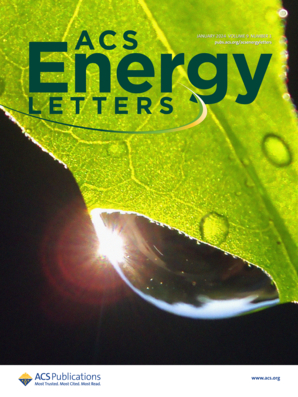Origin of Solid Electrolyte Interphase Heterogeneity on Lithium Metal Anodes and Its Mitigation with Electrolyte Additives
IF 19.3
1区 材料科学
Q1 CHEMISTRY, PHYSICAL
引用次数: 0
Abstract
Lithium metal anode (LMA) stands as a promising candidate for next-generation high-energy-density batteries, yet its viability is critically compromised by heterogeneous solid electrolyte interphase (SEI) formation. This interfacial inhomogeneity manifested as spatially fluctuating Li+ transport kinetics provokes erratic lithium deposition and dendrite propagation. Here, we reveal that current strategies to homogenize SEI are impeded by an overlooked origin: crystallographic anisotropy-driven adsorption bias of electrolyte components across polycrystalline Li (poly-Li) surfaces, thereby dictating SEI heterogeneity. We further decouple the correlation between lattice orientation and adsorption energetics by engineering a dual-additive electrolyte [fluoroethylene carbonate (FEC) and propane sultone (PS)]. These additives establish plane adsorption uniformity, forming a homogeneous SEI that spatially synchronizes Li+ flux. When paired with a high-loading LiCoO2 cathode (3.86 mAh cm–2), the stabilized anode enables 80% capacity retention over 380 cycles under ultralean conditions (N/P = 2.30, E/C = 2.34 g Ah–1), tripling the cycle life versus conventional electrolytes while suppressing dendritic failure modes.

金属锂阳极固体电解质间相不均匀性的成因及电解质添加剂的缓解
锂金属阳极(LMA)是下一代高能量密度电池的一个有前途的候选材料,但其可行性受到非均质固体电解质间相(SEI)形成的严重影响。这种界面不均匀性表现为空间波动的Li+输运动力学,引起不稳定的锂沉积和枝晶扩展。在这里,我们揭示了当前的SEI均质化策略受到了一个被忽视的原因的阻碍:晶体各向异性驱动的电解质组分在多晶Li (poly-Li)表面的吸附偏差,从而决定了SEI的非均质性。我们通过设计一种双添加剂电解质[氟碳酸乙烯(FEC)和丙烷磺酮(PS)]进一步解耦了晶格取向和吸附能量之间的相关性。这些添加剂建立了平面吸附均匀性,形成了空间同步Li+通量的均匀SEI。当与高负载LiCoO2阴极(3.86 mAh cm-2)配合使用时,稳定阳极在超净条件下(N/P = 2.30, E/C = 2.34 g Ah-1),在380次循环中保持80%的容量,与传统电解质相比,循环寿命增加了三倍,同时抑制了枝晶失效模式。
本文章由计算机程序翻译,如有差异,请以英文原文为准。
求助全文
约1分钟内获得全文
求助全文
来源期刊

ACS Energy Letters
Energy-Renewable Energy, Sustainability and the Environment
CiteScore
31.20
自引率
5.00%
发文量
469
审稿时长
1 months
期刊介绍:
ACS Energy Letters is a monthly journal that publishes papers reporting new scientific advances in energy research. The journal focuses on topics that are of interest to scientists working in the fundamental and applied sciences. Rapid publication is a central criterion for acceptance, and the journal is known for its quick publication times, with an average of 4-6 weeks from submission to web publication in As Soon As Publishable format.
ACS Energy Letters is ranked as the number one journal in the Web of Science Electrochemistry category. It also ranks within the top 10 journals for Physical Chemistry, Energy & Fuels, and Nanoscience & Nanotechnology.
The journal offers several types of articles, including Letters, Energy Express, Perspectives, Reviews, Editorials, Viewpoints and Energy Focus. Additionally, authors have the option to submit videos that summarize or support the information presented in a Perspective or Review article, which can be highlighted on the journal's website. ACS Energy Letters is abstracted and indexed in Chemical Abstracts Service/SciFinder, EBSCO-summon, PubMed, Web of Science, Scopus and Portico.
 求助内容:
求助内容: 应助结果提醒方式:
应助结果提醒方式:


